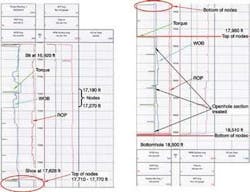Wellbore pressure containment integrity treatments increase leakoff test pressures
Randy Vincent, Former Chevron
David Traugott, Former Halliburton
Ron Sweatman, Halliburton
Two wellbore pressure-containment integrity (WPCI) treatments worked in 852 ft (260 m) of open hole in the last sidetrack for a production hole section in a deep, high-pressure/high-temperature (HP/HT) well in the western Gulf of Mexico shelf offshore Louisiana. These treatments raised the leakoff test (LOT) across the entire 852 ft (260 m) of open hole to 19.1 ppg equivalent, making it unnecessary to set pipe early, which could have jeopardized the commercial discovery of the lower gas sand. Earlier sidetracks attempted unsuccessfully to bypass the loss/flow problems that would not allow drilling ahead and increasing the 18.0 ppg mud weight (MW) to drill into a high-pressure zone. Various conventional lost-circulation material (LCM) treatments were used without success, increasing the hole’s pressure containment.
Challenging shelf region
The western continental shelf in the GoM is known as one of the most challenging areas in the world to drill. Faulted formations, HP/HT conditions, abnormal pressure ramps, depleted reservoirs, and lost circulation are a few of the challenges operators meet on a regular basis.
Area structural maps detail the many faults. The well path of an example wellbore in this region encountered many of these faulted areas; the fault lines indicated why pressure integrity issues were encountered while drilling.
The main reason this well encountered so many pressure integrity challenges was that the mud-weight window (MWW) was too narrow.
Two weak zones were identified clearly before the WPCI job: one just below the shoe at 17,628-17,710 ft (5,373-5,398 m) measured depth (MD), or 16,038 ft (4,888 m) total vertical depth (TVD), and the other at 18,480–18,520 ft MD (5,632-5,645 m), or 16,679 ft (5,084 m) TVD.
Before the WPCI treatments, the maximum MW of 18.0 ppg was too low to hold back the lower production sand; as soon as the MW was increased, the well began to lose fluid to weak zones uphole.
A number of conventional LCM treatments were used in an attempt to stop mud losses, but these had limited success and did not increase the WPCI of the well. Finally, on the second sidetrack, two WPCI treatments were used to increase the pressure-containment integrity from 18.26 to 19.1 ppg. These treatments allowed for an increase in the MW to 18.3 ppg with no losses and permitted drilling through the production sand to total depth (TD).
Borehole strengthening
An open hole’s WPCI may be increased to widen the MWW using various mechanisms and materials. One of the challenges is to understand enough about the types of formations in the open hole and the associated leakoff flow paths initially to select the best approach rather than applying trial-and-error. The former can save significant amounts of rig time and well costs versus the latter, which can, and has, resulted in high costs (10 to 100% over the authority for expenditures), sidetracks, bypasses, and abandoned wells.
When offset well data is not available or applicable, real-time measurements can be used as the input data for analysis to help determine the leakoff flow path characteristics. The results of the data analysis may provide the understanding needed to select the most cost-effective approach.
Treatment design
To design and place an effective WPCI treatment, a defined set of procedures must be completed before the job. These steps outline the procedure followed to optimize the treatment design:
1. Estimate fracture dimension by modeling formation properties. Inputs into the model include historical rate/volume/pressure data, analysis of rock properties, in-situ stress values, pore pressure estimates, and fluid rheologies. Also, define the objective WPCI needed to drill ahead.
2. Calculate the required sustainable fracture width using the linear elastic modeling equation. This is a basic equation from hydraulic fracturing theory for a penny-shaped fracture.
- **∆P = pressure within the fracture above the minimum principal in-situ stress
- **w=fracture width
- **R=fracture radius
- **E=formation Young’s modulus
- **v=formation Poisson’s ratio
3. Determine the required amount of sealant volume using the fluid mechanics equation. Factors to determine include: sealing material yield stress at bottomhole static temperature (BHST), minimum required sealing material volume, and retained volume after releasing surface pressure.
4. Finalize the job plan, including details about pressure/rate limitations, the volume of sealant to be left in the wellbore, total downhole sealant volume, material mixing ratio, optimum spacer volumes, and contingency plans.
5. Use stress equations to predict WPCI increase using equivalent circulating density (ECD) or LOT data. Increased stresses resulting from widening fractures and faults and the formation of a flexible pressure seal are key mechanisms influencing borehole pressure-integrity (BHPI) increases.
6. Fine-tune and finalize the sealant formulation by lab testing with drilling fluid from the actual wellbore to be treated.
For this particular job, volume was determined empirically based on loss rates and the suspected fracture gradient (FG) of the loss zone determined by a previous openhole LOT. The openhole volume at the time of the job was approximately 36.5 bbl. The determination to go with a 50-bbl yielded volume (25-bbl surface volume) was based on the loss-zone length, the analysis of the LOT, and the understanding of the permeable sand zone.
Job execution
The pumping schedule was designed to commingle the WPCI sealant slurry and the mud at two different rates, allowing the commingled fluid the capability to reach the loss zone, then divert to other areas of weakness in the well. After the initial 10 bbl of sealant-slurry material was displaced from the workstring, the rates were reduced to a 3 bbl/min commingled rate because of a casing burst-pressure limitation of 2,500 psi. This reduction in rate caused the system to begin slowing while at the same time continuing to divert and build nodes across the zones taking the most fluid.
A running squeeze was then sought as the treatment built in the openhole areas taking the most fluid. During the entire process, hydraulics were taken into account and a “first hit” was determined when a pressure-curve slope change and a significant pressure increase were seen. A first hit is determined when a sustained slope change on the pressure curve deviates from the actual trend. This point in time on the curve represents the moment when the product enters the formation for the first time. The first hit identification allows a calculated volume of displacement to be determined while the treatment is still being displaced into the well.
Displacement was discontinued when the ΔP was no longer increasing. At this point in the displacement, hesitation methods called “pack and bleed” were used to reduce the pressure lost during shut-in periods and to make a correlation to the closure stress. This allowed the material to compact into the fracture and create nodes across the loss areas. When a significant portion of the treatment is determined to be displaced, the repeated pack and bleed closure stress is constant, and the bleed-off rate is optimally less than 50 psi/min. At that point, the surface pressure was slowly bled off to zero and the cleanout process was performed.
Real-time operations support
Real-time operations (RTO) support is a valuable tool during job placement, and especially during cleanout. In the last decade, advances in communications technology have allowed drastic improvements regarding the transfer of data across the wireless link connecting operations support personnel in the office to the operating personnel offshore. Enabling technical support staff to view in real time the parameters associated with the placement of the sealant definitely benefits everyone. As the job is being executed, the engineer on location contacts technical experts to discuss the pressure/rate curves. Important decisions are made by the team rather than by one individual.
Data acquired by a microprocessor on the cementing unit is passed via wellsite information transfer standards (WITS) to the measurement while drilling (MWD) unit and is then passed by satellite to a server in the office. Having extra assistance in the office allows the supervisor and engineers on location to handle operational issues with confidence. To summarize, RTO can allow experts to analyze pressure and rate data to interpret formation characteristics and optimize the placement of the sealant into the formation.
First treatment evaluation
After the first treatment’s continuous squeeze, a pack and bleed procedure was performed to help evaluate the WPCI system’s sealing of faults and fractures in the hole. The pressure response showed increased pressures after the first two pumping stages in the hesitation squeeze. After the third pumping stage however, pressures appeared lower; therefore, pumping was discontinued. Rather than more pumping at that time, pressure was allowed to stabilize. Also, it was hoped that the sealing system would cure or vulcanize to a degree and create a stronger seal.
At the end of the pack and bleed procedure, it was determined that a much higher fracture closure pressure of 1,408 psi had been achieved as calculated below:
- Equivalent mud weight (EMW) =
- {1,408 psi/ (16,764 ft × .05195)} +
- 18.0 ppg = 19.6 ppge
After the pack and bleed procedure, the cleanout procedure specific to this type of treatment was performed. Rig personnel were given a demonstration of the downhole-activated consistency of the WPCI sealant to reach an agreement for a slow rate of penetration (ROP) to prevent packing off around the bottomhole assembly (BHA) while washing through the excess sealant left inside the hole.
Cleanout procedure
The “geolo-graph” log represents the openhole and rig conditions during the cleanup procedure after the first treatment. When hole-cleaning ROP is sufficiently slow (<100 ft/hr), drill parameters such as weight on bit (WOB), rate of penetration (ROP), and torque on bit (TOB) can be analyzed to help determine where the treatment sealant was placed inside faults and fractures and where excess sealant was left in the hole. WPCI sealants have strong cohesive and moldable consistency properties that can give higher TOB readings when washed out of the hole. The calculated treatment volumes pumped indicated that the sealant’s tail was displaced to just above the shoe. This matched the log’s TOB readings in the cased-hole section showing there were very small amounts of sealant left in the hole just below the point where the bit was spotted during the treatment and in a few short intervals at lower depths inside the casing.
LOT analysis
A chart of LOT pressures taken in the entire 852 ft (260 m) of open hole before the WPCI treatments was made. The LOT after the hole was cleaned following the first WPCI treatment and resulted in the EMW below representing the fracture initiation pressure (FIP), also called the hole’s WPCI.
- EMW = {730 psi/ (16,764 ft × .05195)} +
- 18.0 ppg =18.8 ppge
Second treatment
Even though the difference between the LOT before the first WPCI treatment and the LOT after the first treatment was substantial (18.8 – 18.2 = 0.6 ppge), this increase in WPCI was not enough to drill ahead safely. A 19.1 ppge was required to deepen the hole a few hundred feet to expose the target sand allowing the operator to reach TD in this production section. This, along with the results of the hole cleanout analysis, pointed out an opportunity to place more sealant to reach the desired 19.1-ppge WPCI (0.9-ppge increase).
Second treatment evaluation
After the second treatment continuous squeeze, the pack and bleed procedure was performed to help evaluate the WPCI system’s sealing results. A chart of the pack and bleed sealing pressure response illustrated good sealing characteristics by the steep pressure buildup and adequate fall-off slopes as the pumping starts up and shuts down. This information helped the operator decide to end the treatment and start the hole cleanout procedure (same as first job).
Cleanout procedure
After the second treatment cleanout stage, a well log clearly indicated where the WPCI sealant was placed in the open hole. The TOB values indicated that the second treatment’s sealant placement successfully treated intervals that were not well treated during the first treatment, such as the interval from 18,320 to 18,510 ft (5,584 to 5,642 m). This analysis helped operators predict that all intervals were well treated, which was later confirmed by the post-job LOT.
LOT analysis
A chart indicates the LOT pressures as tested across all the formations after the 852 ft (260 m) open hole was cleaned out following the second WPCI treatment. The EMW calculation of 19.2 ppge was based on the 16,038-ft (4,888-m) TVD at the shoe. The same test data was used to calculate the EMW based on the 16,764 ft (5,110 m) TVD at the bottom of the hole, which gave a difference (shoe vs. bottomhole) of 0.1 ppge less (19.1 ppge). However, this did not change the overall increase of ~0.9 ppge in the hole’s WPCI across all exposed formations, i.e., the same calculation method showed nearly identical increases in WPCI whether based on shoe or bottomhole TVD. The following EMW calculation is for the FIP found in the LOT, based on the bottomhole TVD.
- EMW = {970 psi/ (16,764 ft × .05195)} +
- 18.0 ppg =19.1 ppge
In both calculations (shoe vs. bottomhole), the EMW obtained was enough to drill deeper safely to expose the lower target sand and to complete the well successfully.
Acknowledgements
The authors thank the managements of Chevron and Halliburton for permission to publish this article. They also thank their colleagues participating in the well and WPCI treatment operations and engineering. Special thanks go to Francisco Rueda and Rick Goosen for their contributions to this article.




